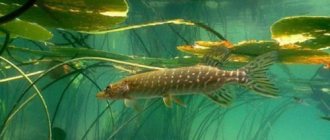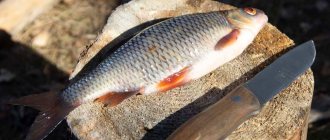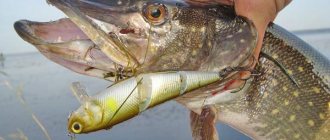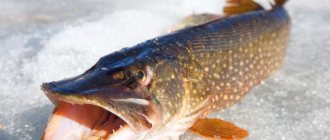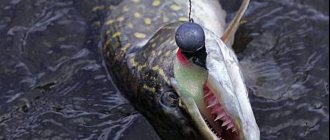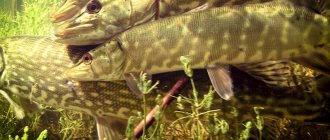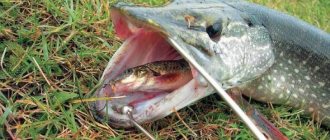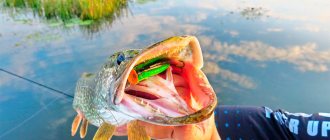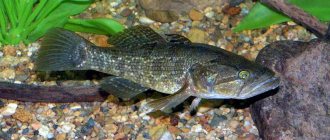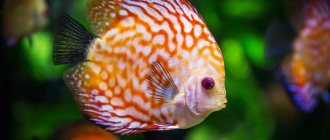Underwater fishing for pike is very popular in our country, but why? Pike is widespread in our waters, so few fishermen have never caught it. Even avid crucian fishermen sometimes come across a spotted predator, and they sincerely rejoice at such prey.
For underwater hunters, pike is also a desirable trophy. The main reason for this is its size. Many dirty tricks can boast of shot “crocodiles” weighing 12-15 kg, and this is far from the limit. Even larger specimens easily tear off arrows or tear their own belly after an unsuccessful shot and swim away with their entrails falling out. It is the power of this fish and the persistent struggle for life that makes hunters dive again and again in the hope of meeting a worthy opponent.
Unlike some other predators, pike does not chase its prey headlong. She prefers to sit in ambush and get food in one swift throw. It must be said that it is not always accurate. Either the water is too cloudy, or the calculation is wrong, but it often misses, as the pitfalls have repeatedly proven. There were cases when this fish made a mistake with the direction and hit the hunter in the jaw, right under the mask. After such an attack, he returned to the shore, feeling like a boxer who had come under attack.
The toothiness of the pike is admirable. Her mouth is stuffed with an incredible number of sharp teeth, straight and oblique, large and small. This formidable weapon leaves its victims no chance of salvation. Only those whom the predator considers inedible or tasteless will be lucky.
For example, many spearfishing enthusiasts have repeatedly seen it attack a frog, grab it with its teeth, chew it a little, and then spit it out. Apparently it wasn't to my taste.
By the way, a hungry pike attacks any living creature that does not reach a third of its own size, and what is most interesting is that approximately 15% of its diet consists of young pike up to 10 cm in length. It does not even disdain its relatives!
Some subtleties of spearfishing for pike
The main secret of successful underwater hunting for large pike is that the hunter must be the first to notice the prey. If she turns out to be more attentive, she will quickly leave the dangerous area of the reservoir, not giving her the opportunity to shoot. That is why many tricksters first “tune” their vision - they find a small bee-eater, simply watch it for a while, and only then begin the real hunt. It is important to remember the outlines of the pike, the structure of the body, its every movement, and then scroll through the picture before your eyes. Such visual preparation helps to notice a predator even in dense reeds or reeds.
Sometimes, when wading through dense underwater vegetation, it is useful to freeze in a promising place and remain motionless for several minutes. At such moments, the head of a trophy pike often appears from the grass, in which curiosity has prevailed over the instinct of self-preservation. Any large predator diligently guards its territory and will definitely want to find out who dared to invade its domain. Here it is, a great opportunity to get a trophy!
No one is afraid of a big pike, so it is not at all necessary that it immediately retreats. She can observe from a safe distance an incomprehensible large creature (in our case, a hunter) in order to assess her strength and decide what to do next: swim away or try to defend the territory. If at the same time the catch begins to back away, most likely the predator will slowly follow him. She needs to make sure that the aggressor has left her property. Sometimes a hunter notices not the pike itself, but only indirect signs of its presence. These are small clouds of turbidity raised by a predator a second ago. Here you need to be especially careful and attentive; at such moments you need to concentrate not on the bottom surface, but consider the bottom and middle horizons. The pike moves out of the way of the trick, but not far, sometimes within visual distance. You can stumble upon it at any second. The main thing is to see it first and make an accurate shot.
Where are you my beauty?
It hunts mainly in the morning and by noon, when the upper layers of water begin to warm up, the pike goes to the depths. After an active hunt, the pike noticeably slows down and stands more and more in one place, digesting breakfast. This is where it’s time to go spearfishing.
You can hunt pike both during the day and at night. This predator is as active at night as during the day. There are quite a few ways to spearfish for pike. Let's look at just a few of them, those that are most effective.
And so, if you come to hunt only for pike, you need to calibrate your vision when immersed in water. What does this mean, and this means the following, try to imagine this pike, its fins, muzzle, tail before your eyes, so it will be easier for you to notice it in the future. It’s as if you’ve already programmed your brain to look for pike.
Next, we begin to comb places with abundant aquatic vegetation, since it is in these places that the probability of pike habitat is very high. This is a suitable place for pike to feed. When diving into overgrown areas, you need to move very carefully without raising a cloud of turbidity behind you. Since the toothy beauty is very timid, try to look not only straight ahead, but also to the sides. There is also a high probability of finding a pike lying on the bottom after eating.
Another method is the laying method, which I talked about a little earlier, you can read more about laying here in the article spearfishing in troubled water.
Weapon Selection
Crossbow or pneumatic? All beginners ask this question, but experienced hunters know for sure: for a targeted hunt for a spotted beauty, it is better to take a crossbow. Thanks to its reliability, simplicity of design, safe charging and high accuracy, this weapon has become the most popular among professionals. The crossbow has several advantages. This:
a simple mechanism that almost never fails or breaks down;- noiselessness of the shot, which is very important under water;
- shot power, allowing you to hit a target from a distance of up to 7 meters (for comparison: the limit of an air gun is 4 meters).
With a gun behind a pike
| Pike, like crucian carp, is the most popular fish in Rus'. How many fables have been written about her, how many fairy tales and fables have been told! Such popularity of the spotted green predator is obviously explained by the fact that it is found almost everywhere, in all climatic zones, wherever Russian people live. Pike can settle equally well in a fast mountain river and a flowing lake, in cold northern and warm southern waters, in clear and always muddy reservoirs. It even lives in the brackish bays of the Caspian and Baltic seas. |
There is hardly a fisherman, even a very bad one, who has never caught a pike. For underwater hunters, these fish are also not rare prey, but they are always desirable. And there are many reasons for this. Firstly, pike reach very large sizes. There is numerous evidence of the existence of specimens up to two and even two and a half meters long. Real “crocodiles” of the Russian land! Many of us, talking about our best trophies, can easily spread our arms out to the sides, and this will not be a fishing tale. Fish weighing 10, 12, 16 kilograms often became the prey of underwater hunters. Even larger pikes either escaped unharmed from the shocked hunters, or carried away the torn arrows with them. It happens that after a not very successful shot, this strong fish tears itself apart and, not paying attention to the dangling entrails, rushes away. Such power and active struggle for their lives and freedom are another attractive factor in the hunt for them. Pike, like catfish and unlike asp and perch, extremely rarely chases its chosen victim. Usually the hunt ends with one throw, regardless of whether it is successful or not. But this throw is so fast that sometimes you can’t even catch in which direction the fish disappeared. And the pike itself, in troubled water or in the heat of battle, does not always successfully choose the right direction. Personally, I experienced this myself twice: once a one-kilogram pike, falling from an arrow, knocked off my mask under water, and the other time, in the thick grass, a larger fish hit me in the jaw, so much so that my cheekbone hurt for several days afterwards - clean knockdown. Not a single freshwater predator can compare with pike in terms of “toothiness”. The huge pike mouth is stuffed with dozens and hundreds of large and small sharp teeth, many of which have the ability to bend down and let prey inside. A predator loses teeth easily: new ones will still grow after a while, but this process is not simultaneous. Such powerful and versatile weapons leave no hope of salvation for anyone who is tough on this pike. And she can handle any victim that is in the water and does not exceed a third of its own size. 20% of the victims are... pike! She grabs her victim as needed. Then, in some incredible way, he turns her head towards him and swallows her. At the same time, if she wants, she easily spits out what she doesn’t like. I myself watched how a pike caught a frog, grabbed it in its mouth for quite a long time, so that the unfortunate amphibian completely disappeared into it, and then let go. Lyaga disappeared behind my back, and the predator did not even think of attacking her a second time. Apparently I didn't like it...
Over decades of underwater hunting, we have studied our heroine well. During the day, it most often hides in the densest thickets of underwater vegetation; individual pikes are on duty in the branches of underwater bushes and in underwater rubble. The largest predators spend almost all their time at great depths. At night, they can go to shallow depths, catch prey at dawn and again retire to the dark and calm corners of the reservoir. The rule almost always applies: where a possible pike victim is located, that’s where you should look for it. We also noted an interesting pattern. If we manage to find a school of ides, scattered and hidden in the interweaving of water lilies and pondweed, then we often find a large pike nearby, or even more than one. It seems that they tend their personal flock, following it, and, if necessary, take tribute from it. And further. Sometimes, for some reason, large pike gather in one place. Spawning has long passed, the pike do not settle down for the winter, and we can’t imagine what such an important issue the patriarchs of the reservoir are going to discuss at such a gathering... In winter, all the pike are kept in the remains of pondweed. It happened that you floated down the river 100, 200 meters - and nothing, but as soon as grass appeared (which you can’t even call grass: just some kind of ropes, bent by the current to the bottom), wait for a meeting with this predator. And for sure: here she is - gray on top, always standing with her head towards the current and at the bottom, so as not to waste precious energy. This position of the fish and the shallow depth allow the hunter to confidently shoot it, having a multi-pronged tip without hooks. There are practically no escapes also because during such shooting the fish receives a blow on the back with the bar of a multi-toothed fish. The fact that in winter pike are frequent guests on fishermen’s hooks and hunters’ arrows is predetermined not only by their large numbers, but also by their relatively high activity. “Relatively” because as the water temperature drops, the activity of all (burbot does not count!) of our freshwater fish decreases. In October-November, when the water temperature drops to 4–50C, pikes can still be very shy and take off with pure summer agility. Pike activity sharply decreases only in March-April, which is caused more by the approach of spawning than by weather factors. At this time, pike lie on the bottom for a long time without moving. At the same time, they are sprinkled with a coating of silt, which is much less in cold water than in hot weather. And dozens of leeches comfortably nest on their jaws, gill covers and scales. Many fish have empty stomachs, but they are clearly not in the process of hunting. And if we have long known that a well-fed pike is less shy than a hungry one, then here this rule of summer time is not confirmed: pikes are both hungry and not shy.
Unlike pike perch, pike rarely go in schools with bream, ide or roach. I have only observed this twice, and both times in a winter river. Science says that the larger the eyes of fish, the better their vision and, accordingly, the less developed their other senses. Our beauty, you know, has big and expressive yellow eyes. It is with her eyes that she discovers the object of her hunt, and therefore her activity is limited to daylight hours. But in the case when the hunter is a person, and the pike acts as the victim, everything is different. My personal experience suggests that it is easier to approach a pike for a shot from the head rather than from the tail. Especially if you go rafting, that is, without actually moving in the water column and without affecting the lateral line of the fish. The light of a flashlight, if it does not hit the pike directly in the eyes at close range, does not frighten the pike: by shining it from the side from above or from behind, you will always have time to make an aimed shot. Bream, ide, chub, roach, perch, catfish, and all other fish of our fresh water bodies only move in the water column during the day, and hang out and stand half-water quite rarely. This is normal for pike. Therefore, when a hunter moves through not too dense aquatic vegetation, he should not only keep his eyes on the bottom, but also look up. Such pikes, which are not standing near the bottom, usually have empty stomachs, and for them this position is an ambush. After a successful hunt, the pike hides in the strongest and quietest place and lies down on the bottom to digest its prey. At this time she is less timid. On the torpedo-shaped body of a pike, it is difficult to determine the killing spot for an underwater gun. It is easier to name the places where you should not shoot: the stomach and the front of the head, i.e. those parts of the body that are easily torn by the fish itself. The most successful shot is the one that damages the spine: this immobilizes any monster. Sincere surprise is caused by the footage of some advertising films, in which experienced (?) fishermen take caught pike under the gills. It is not clear how they manage to then remove their fingers from under the gill covers without being cut? We have long adapted to grab this fish by the eye sockets - conveniently, safely and reliably. However, there are “buts” here too. Once, when I tried to hold a slightly wounded eight-kilogram pike in this way, it bent and twisted so much at the same time that it almost twisted my fingers. Because of the toothy mouth, hunters place already shot pike even on kukan in a special way. We make sure that the jaws are “locked”, i.e. We pierce the upper and lower jaws with a kukan needle. If it is not possible to pull the kukan to the belt by winding its free part around the front weight, then it is better to pass the kukan needle through the jaws again. Then the toothy predator, under the influence of the oncoming flow of water, will definitely not open its mouth and will not taste anything of yours. In the meantime, they haven’t figured out how many torn wetsuits, rubber gloves, how many ruined hunts! It is no secret that wounded catfish and bluefish, when on an arrow or harpoon line, often attack and bite their offenders, and the largest of the catfish breed are even the first to attack a person. Pike - never, no matter how big it is. There is only one known case, which occurred near Astrakhan in one of the ilmens, when a large pike cut the foot of a bathing woman. But eyewitnesses believe that this is not due to the bloodthirsty nature of the predator, but... to the pedicure. It seems that the pike was simply deceived, mistaking the flashing bright red nails for the plumage of the same rudd. In the fishing literature, there is an opinion that pike perch displaces pike from those reservoirs or areas of reservoirs that it likes. Underwater hunters will neither confirm nor deny this, because very often we encounter both predators together in a small area of water. At the same time, the fact of protecting one’s territory from uninvited guests and possible competitors is beyond doubt. In life it looks like this. You slowly swim into a small, cozy lagoon, and immediately from the far part, from the wall of reeds, a meter-long pike appears - the owner of this water area. She slowly and completely openly heads straight towards you. One and a half to two meters away, he stops, assessing the enemy, boring into you with a predatory, clearly unfriendly look. Having obviously realized that the forces are unequal, the pike smoothly turns around and moves away with dignity, unless, of course... you were gape and didn’t shoot. Yes, we often meet pike, we are used to it. But let's look at it as if we were seeing it for the first time. What a perfect form, what expressive and moving eyes! We admire spotted salmon and bright overseas fish, and our native pike is decorated no worse: spots and stains of various shapes with a unique marble pattern cover the entire body and fins, the caudal and anal fins are red-orange... One word - our Russian beauty!
photo by Mikhail Biryukov
Pike are a genus of freshwater fish , the only one in the pike family, common in Europe, Siberia and North America. They can reach 1.8 meters in length and 47 kilograms in weight. They live up to 30 years. The body is long, torpedo-shaped, the dorsal and anal fins are strongly displaced back, which allows for rapid throws. Leads a predominantly sedentary lifestyle. In October-November, together with other fish, it moves away from the shores to the depths. In March-April it goes to shallow water and prepares for spawning. Spawning begins at a water temperature of 4–60C, the most intense spawning at a temperature of 7–130C. In reservoirs, spawning is shifted a month later than in rivers. Males mature at the age of one to two years, females at two to three years.
Vitaly VINOGRADOV Photo by the author
